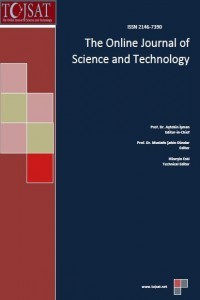The Shell Characteristics of Land Snail Eobania Vermiculata (Müller, 1774) From Croatia
The Shell Characteristics of Land Snail Eobania Vermiculata (Müller, 1774) From Croatia
Shell of land snaill, Eobania Vermiculata, Croatian Study,
___
- Berberović, LJ. (1963). Mikroevolucija vrste Eobania vermiculata (Müll.) na srednjejadranskom primorju i ostrvima. Godišnjak Biol. Instituta u Sarajevu, 16 (1/2): 3- 76.
- Berberović, LJ. (1964). Nova podvrsta kopnenih puţeva sa ostrva Palagruža u Jadranskom moru. Godišnjak Biol. Instituta u Sarajevu, 17: 3-12.
- Bole, J. (1969). Subspecifična diferenciacija polžev na otokih in čereh ob zahodni obali Istre. Dissertationes classis IV. Academia scientiarum et artium Slovenica, 12 (3): 139-151.
- Cook, L., & O'Donald, P. (1971). Shell size and natural selection in Cepea nemoralis. In: E.R. Creed, eds., Ecological Genetics and Evolution. Blackwell Scientific Publications, Oxford and Edinburgh. Pp. 93-108.
- Cowie, R. H., Dillon, R. T., Robinson, D. G. & Smith, J. W.(2009). "Alien non-marine snails and slugs of priority quarantine importance in the United States: A preliminary risk assessment". American Malacological Bulletin, 27: 113-132.
- Dedov, I.K. (1998). Annotated check-list of the Bulgarian terrestrial snails (Mollusca, Gastropoda). Linzer Biol. Beitr. 30/2: 745-765.
- Filin, Z., & Ziv, Y. (2004). New theory of insular evolution: unifying the loss of dispersability and body-mass change. Evolutionary Ecology Recearch, 6: 115-124.
- Jaeckel, S.G., Klemm,W., & Meise, W. (1957). Die land und Süsswasser mollusken der nördlichen Balkanhalbinsel. Abh. Ber. Mus. Tierk. Dresden., 23 (2): 141–205.
- La Graeca, M., & Sacchi, C.F. (1957). Problemi del popolamento animale nelle piccole isole mediterranee. Annuario dell' Ist. e Museo di zool. dell' Università di Napoli, 9,3.
- Lazaridou-Dimitriadou, M., Karakousis, Y., & Staikou, A. (1994). Geographical variation in shell morphology and isoenzymes of Helix aspersa Müller, 1774 (Gastropoda, Pulmonata), the edible land snail, from Greece and Cyprus. Heredity, 72: 23-35.
- Örstan, A., Pearce, T.A., & Welter-Schultes, F. (2005). Land snail diversity in a threatened limestone district near Istanbul, Turkey. Animal Biodiversity and Conservation, 28(2): 181-188.
- Palkovacs, E.P. (2003). Explaining adaptive shifts in body size on islands: a life history approach. Oikos 103: 37-44.
- Pavletić, Z. 1978. Pregled i analiza flore Palagruških otoka. Biosistematika, 4(1): 39-47.
- Sacchi, C.F. (1957). Relazioni tra superficie insulare e mole corporea in Eobania vermiculata (Müll.) dell' Arcipelago toscano. Bollettino di zoologia, 24.
- Stossich, M. (1877). Sulla geologia e zoologia dell’isola di Pelagosa. Boll. Soc. Adriat. Sci.Nat.Trieste, 3(2): 184–192.
- Štamol, V. (2004). Terrestrial snails (Mollusca: Gastropoda terrestria) of the Telaščica Nature Park (Dugi otok, Croatia). Natura Croatica, 13 (2): 95–113.
- Štamol, V., & Kletečki, E. (2005). Terrestrial snails (Mollusca: Gastropoda terrestria) of the Telaščica Nature Park (Dugi otok, Croatia). Natura Croatica, 14 (1): 1–28.
- Štamol, V. (2010). A list of land snails (Mollusca: Gastropoda) of Croatia, with recommendations for their croatian names. Natura Croaica, 19 (1): 1–76.
- Šegota, T. (1968). Morska razina u holocenu i mlađem Würmu. Geografski glasnik, 30: 15-39.
- Šegota, T., & Filipčić. A. (1991). Arheološki i geološki pokazatelji holocenskog položaja razine mora na istočnoj obali Jadranskog mora. Rad HAZU, 458 (25): 149-172.
- Trinajstić, I. (1973). O zoni sveze Oleo-Ceratonion u istočnojadranskom dijelu Balkanskog poluotoka. Ekologija, 8(2): 283- 294.
- Trošić, Ž., Jašić, D., & Marinković, V. (2003). Climatic features of Palagruţa island, Croatia. Geoadria, 1: 39-46.
- Welter-Schultes, F.W., & Williams, M.R. (1999). History, island area and habitat availability determine land snail species richness of Aegean islands. Journal of Biogeography, 26: 239-249.
- ISSN: 2146-7390
- Başlangıç: 2011
- Yayıncı: The association of science, education and technology
Character Level Authorship Attribution for Turkish Text Documents
The Effect of Hypergravity on the Germination and Growth of Eruca Sativa Mill
MARLISE ARAUJO DOS SANTOS, THAIS RUSSOMANO, FLAVIA NATHIELY SILVEIRA FACHEL, EDUARDO CASSEL, LEANDRO VIEIRA ASTARITA
Adaptation Measures in EIA and Risks Management: An Overview of the Legal Framework in Pakistan
Zulfiqar Ali, Daulat Khan, Rashid Hussain
Municipal Solid Wastes Gasification/Polymer Electrolyte Membrane Fuel Cell Integrated CHP System
Ademola Rabiu, Ismail Adefeso, Daniel Ikhu-Omoregbe
Probiotic Potential of Lactic Acid Bacteria Isolated from Human Gut
Laboratory Stands for Wideband Analysis Radiocommunication Signals
Ryszard Studanski, Radosław Was, Agnieszka Studanska, Jarosław Garus
Semantic Adaptation Approach for Adaptive Web-Based Systems
Bujar Raufi, Artan Luma, Xhemal Zenuni, Florije Ismaili
The effect of monks in the Hungarian Urban Design and Landscape Forming
Virtualmatriks: A Conceptual Mathematization Process in Virtual Learning Environment
Myco and Phyto Remediation of Heavy Metals from Aqueous Solution
